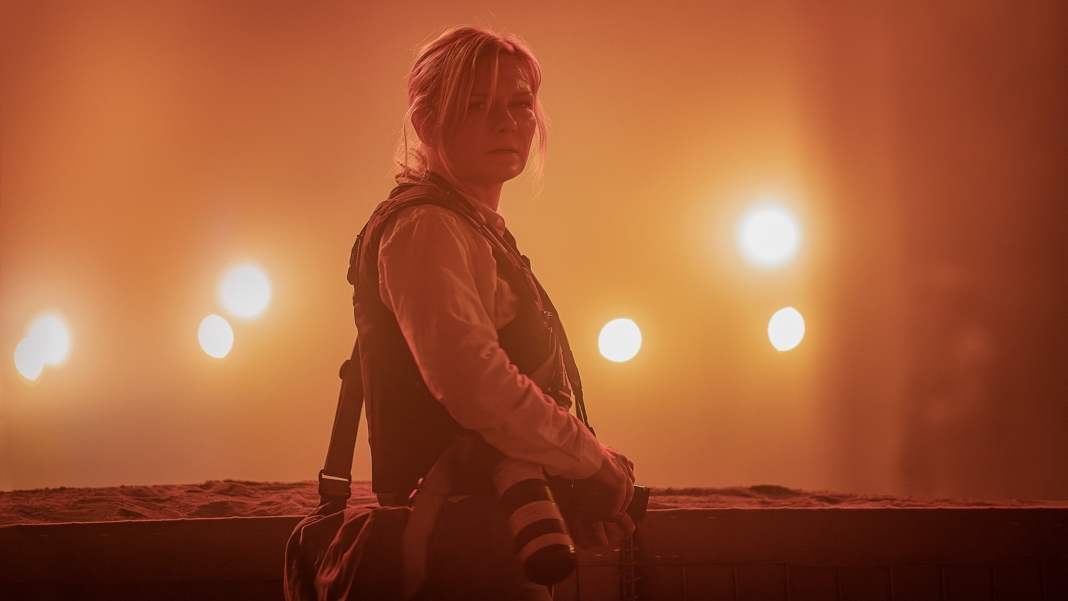
Listen to this article
Produced by ElevenLabs and News Over Audio (NOA) using AI narration.
In Alex Garland’s new film, Civil War, the United States has fallen into an internecine conflict pitting the government against separatist forces—a narrative with uncomfortable resonance in these politically polarized times. Unlike in our own world, it’s never really clear in the movie why the nation is fighting itself. We kick off with vague talk of “western forces” and an implausible-sounding alliance between Texas and California, but there isn’t much more explanatory world-building. All we know is that America is a battleground; the other blanks can be filled in however you’d like.
That may sound frustrating, but anyone familiar with Garland’s storytelling style knows how distant he can seem. His prior films (Ex Machina, Annihilation, and Men) took what could have been complicated, lore-heavy genre premises and stripped them down into something stark and more alienating. Civil War does the same, but with the intensity dialed even higher and the stakes more frighteningly grounded. Yes, the viewer isn’t quite sure what has thrown America into turmoil, beyond the fact that the president (played by Nick Offerman) has stayed in office past his term. But the action that plays out is nauseatingly recognizable, a journey through abandoned towns patrolled by gun-toting militias—a possible vision of our lives knocked askew.
This film might be the largest that Garland has worked on, but he hasn’t lost his talent for keeping his audience off-balance. His protagonists are dispassionate observers, not heroic soldiers: a group of war correspondents, reporters, and photographers trying to sneak through military lines to get at the biggest story in the world. They’re driving toward the siege of Washington, D.C., where the president is making his final stand against invading separatists. Though Civil War ramps up in spectacular fashion during the last act, it’s a road-trip movie for most of its running time.
This formula keeps the action small-scale for the majority of the film. Lee (Kirsten Dunst), a photographer possibly modeled on the famed World War II journalist Lee Miller, is our steely main protagonist, a legend in her field who seems entirely uninterested in whatever ideological divides are fueling the war. She’s accompanied on her trip by Joel (Wagner Moura), a hotheaded veteran reporter who still gets an adrenaline rush from his work; Jessie (Cailee Spaeny), a cub photographer who idolizes Lee; and Sammy (Stephen McKinley Henderson), a newspaperman taking one last trip before retirement.
The performances are strong but not lovable. Dunst is capable of summoning deep wells of emotion with just a look, but Lee’s inner world is largely locked away. Instead, she remains in straight pursuit of a journalistic mission—capturing perfect photos of the unfolding situation—that might seem beside the point to an audience hungry for answers about just what is going on. But it’s with Lee’s mission, and especially in Jessie’s effort to replicate her hero’s fearlessness, that Garland is trying to make his grander point. Lee and her colleagues are apolitical creatures, insistent on not taking sides—but in such extreme circumstances, does it make sense for them to not intervene when they come across human misery? Is Lee serving a moral cause, or is she merely the highest form of thrill junkie?
As with all of his movies, Garland doesn’t provide easy answers. Though Civil War is told with blockbuster oomph, it often feels as frustratingly elliptical as a much smaller movie. Even so, I left the theater quite exhilarated. The film has some of the best combat sequences I’ve seen in a while, and Garland can ratchet up tension as well as any working filmmaker. Beyond that, it’s exciting to watch him scale up his ambitions without diminishing his provocations—there’s no one to root for, and no real reward waiting at the end of this miserable quest.
Source: theatlantic.com



